‘This is one minute to midnight’: British MP visits occupied West Bank
British MP Shockat Adam travelled to the occupied West Bank to see Israel's treatment of Palestinians.
Source link
Stay informed and up-to-date with the latest news from around the world. Our comprehensive news coverage brings you the most relevant and impactful stories in politics, business, technology, entertainment, and more.
British MP Shockat Adam travelled to the occupied West Bank to see Israel's treatment of Palestinians.
Source link
World leaders paid their respects to Pope Francis Friday, ahead of his funeral Saturday, including French President Emmanuel Macron, Brazilian President Luiz Inácio Lula da Silva, Lebanese President Joseph Aoun, Lithuanian President Gitanas Nausėda, and Hungarian Prime Minister Viktor Orbán. More than 250,000 mourners paid their respects over three days.
Published On 25 Apr 202525 Apr 2025

 Reuters
ReutersUS President Donald Trump has said Russia and Ukraine “are very close to a deal”, hours after his envoy Steve Witkoff and Russian President Vladimir Putin held talks in Moscow.
Trump said it had been a “good day” of negotiations, while the Kremlin described the talks – which Ukraine was not present at – as “constructive”.
Earlier, Trump said on social media that “most of the major points are agreed to,” and urged Russia and Ukraine to meet “at very high levels” and “to finish it [the deal] off”.
Meanwhile, Ukrainian President Volodymyr Zelensky said in his video address late on Friday that “real pressure on Russia is needed” to accept an unconditional ceasefire.
Earlier in the day, Zelensky told the BBC that territorial issues between Kyiv and Moscow could be discussed if a “full and unconditional ceasefire” was agreed upon.
Reports suggest Ukraine would be expected to give up large portions of land annexed by Russia under a US peace proposal.
Trump – who spoke to reporters as he arrived in Rome for Saturday’s funeral of Pope Francis – has said he would support Russia keeping the Crimean peninsula, which was illegally annexed by Moscow in 2014. Zelensky rejects this idea.
Russia launched a full-scale invasion of Ukraine in 2022, and Moscow currently controls almost 20% of Ukrainian territory.
On Friday, traffic was halted in Moscow as a convoy of cars carrying Witkoff arrived ahead of the high-level talks, the fourth such visit he has made to Russia since the start of the year.
The three-hour talks were described as “very useful” by Putin aide Yuri Ushakov.
It had brought the “Russian and US positions closer together, not just on Ukraine but also on a range of other international issues”, he said.
“Specifically on the Ukrainian crisis, the possibility of resuming direct talks between Russian and Ukrainian representatives was in particular discussed,” he added.

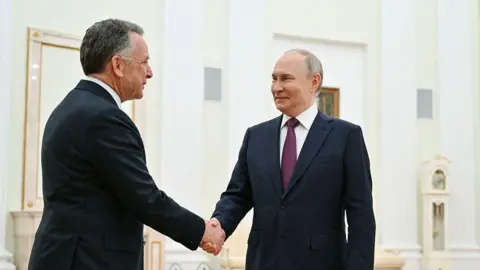 AFP
AFPEarlier this week, Putin signalled for the first time since the early stages of the war that he was open to talks with Zelensky.
His remarks were believed to be in response to a proposal by the Ukrainian president for a 30-hour Easter truce to be extended for 30 days. No truce has yet been agreed on.
Kyiv has been on the receiving end of growing pressure from Trump to accept territorial concessions as part of an agreement with Moscow to end the war.
Crimea has become a particular flashpoint.
Zelensky has repeatedly rejected the idea of recognising the peninsula as part of Russia, telling reporters in Kyiv on Friday: “Our position is unchanged – only the Ukrainian people have the right to decide which territories are Ukrainian.”
However, in later remarks he suggested to the BBC that “a full and unconditional ceasefire opens up the possibility to discuss everything”.
He also referenced comments made by Trump in an interview with Time magazine, in which the US president said “Crimea will stay with Russia”.
“What President Trump says is true, and I agree with him in that today we do not have enough weapons to return control over the Crimean peninsula,” Zelensky said.
Washington’s peace plan has not been publicly released, but reports suggest it proposes Russia keeps the land it has gained – a condition that is in Moscow’s favour.
On Friday, Reuters news agency reported it had seen US proposals handed to European officials last week, as well as subsequent counter-proposals from Europe and Ukraine.
It said there are significant disparities between them.
The US deal offers American legal acceptance of Russia’s illegal annexation of Crimea and de facto recognition of Russian control of other occupied areas, including all of the Luhansk region.
By contrast, the Europeans and Ukrainians will only discuss what happens to occupied Ukrainian territory after a ceasefire has come into effect.
The US plan also rules out Ukraine’s membership in the Nato military alliance, according to Reuters.
As the meeting between Witkoff and Putin was taking place, Trump claimed talks were going in the right direction.
“They’re meeting with Putin right now, as we speak, and we have a lot of things going on, and I think in the end we’re going to end up with a lot of good deals, including tariff deals and trade deals,” he told reporters in the US.
He said his aim was to bring about an end to fighting in Ukraine which he said was claiming the lives of 5,000 Ukrainian and Russians a week, adding he believed “we’re pretty close” to a peace deal.
Trump also said Zelensky had not signed the “final papers on the very important Rare Earths Deal with the United States”.
“It is at least three weeks late,” he said, adding that he hoped it would be signed “immediately”.
The long-talked of minerals deal, which would give the US a stake in Ukraine’s abundant natural resource deposits, was meant to be signed in February but was derailed after an acrimonious meeting between Trump and Zelensky in Washington.
Russia and Ukraine’s positions in securing a peace deal still seem miles apart, with no representative from Ukraine invited to take part in the talks in Moscow.
Writing on social media on Friday, Zelensky criticised Russia for failing to agree to a 30-day ceasefire proposed by the US on 11 March and urged allies to apply more pressure to it.
“It’s been 45 days since Ukraine agreed to President Trump’s proposal for quiet in the sky, sea and the frontline,” he said. “Russia rejects all this. Without pressure this cannot be resolved. Pressure on Russia is necessary.”
He said Russia was being allowed to import missiles from countries such as North Korea, which he said it then used in a deadly missile strike on Kyiv on Thursday, which killed 12 people and injured dozens.
“Insufficient pressure on North Korea and its allies allows them to make such ballistic missiles. The missile that killed the Kyiv residents contained at least 116 parts imported from other countries, and most of them, unfortunately, were made by US companies,” Zelensky alleged.
Following the attack on Kyiv, Trump said he was “putting a lot of pressure” on both sides to end the war, and directly addressed Putin in a post on social media, saying: “Vladimir STOP!”
Since then, however, Trump has blamed Kyiv for starting the war, telling Time magazine: “I think what caused the war to start was when they [Ukraine] started talking about joining Nato.”

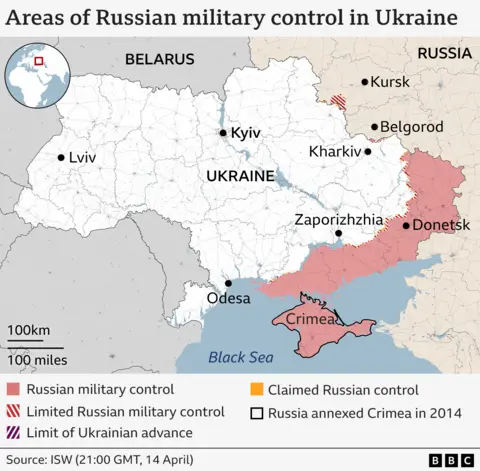
Killing of tourists in Indian-administered Kashmir sparks new crisis.
Source link
As Apple grapples with United States President Donald Trump’s tariff war with China, it has laid out plans to move to Indian assembly of the majority of iPhones it sells in the US by the end of 2026, a move that would double its current output from the South Asian nation and away from China.
The tech giant produces in China 80 percent of the 60 million iPhones sold in the US and this is a key step that would help it mitigate some of the costs it faces amid rising tariffs on China.
The Financial Times first reported Apple’s plans on Friday.
Apple, a company worth more than $3 trillion, is reportedly engaged in discussions with manufacturers it works with in India, including Foxconn and the Tata Group to execute this plan, according to the news agency Reuters, which cited an unnamed source.
The tech giant has already expanded production in India to counter tariffs imposed during the first Trump administration. The Silicon Valley-based tech giant shipped $2bn worth of iPhones in March, accounting for roughly 600 tonnes of cargo from India to the US — a record for both Tata and Foxconn, according to Reuters.
Indian Prime Minister Narendra Modi has been pushing the country as a hub for global smartphone manufacturing. Earlier this year, the country removed import taxes for some components for mobile phone production – a boost for companies like Apple.
“If you’re charging import tax for intermediary goods, then you cannot actually be competitive versus somebody who does not. Their objective is to be as competitive as they can be to become the leading manufacturing hub,” Babak Hafezi, chief executive officer at Hafezi Capital, an international consulting firm, told Al Jazeera.
Apple has assembled roughly $22bn worth of iPhones in India during the 12-month period ending March 2025, a 60 percent increase from the year prior, per a Bloomberg report. Even with the growth, only 20 percent of the world’s iPhones are made in India.
The shift in production will cost Apple. According to a Reuters report citing an unnamed source, manufacturing iPhones in India is 5-8 percent more expensive than in China.
“India will help, but it’s not moving the needle on China’s dependence for Apple. It will take years to make this move, as Apple is caught in the tariff storm,” Dan Ives, analyst at Wedbush Securities, told Al Jazeera.
Earlier this week, the tech outlet The Information reported that Chinese authorities have created roadblocks for Apple suppliers to move operations from China to India. They have delayed shipments or blocked equipment shipments without explanation. In some cases, Foxconn had export applications denied and others delayed up to four months.
“In terms of core iPhone production, it would take years to move a significant piece from China to India,” Ives added, referring to the phone’s components that are made in China and shipped to India to be assembled into the final product.
Ives also said Apple’s plans to move assembly for US phones completely to India could cost the company $30bn-$40bn.
There are concerns if India’s infrastructure can handle the surge in production, as well.
“They have massive amounts of infrastructure problems in terms of traffic and mobility, and all these different variables that make the cost of the production longer, which eventually cost more money for the company,” Hafezi added.
“You need secure, continuous, and productive infrastructure to maximise manufacturing as best as you can and be globally competitive,” he continued.
Apple’s move comes as the Trump administration has signalled a willingness to ease trade tensions between the US and China, amid concerns about the economic fallout from the tariff war.
On Friday, Trump claimed he had spoken to Chinese President Xi Jinping but did not say when the two leaders last talked. In a TIME magazine interview conducted earlier this week, Trump said that his administration has been talking with Beijing to strike a tariff deal. China has denied any trade talks with the US.
But trade talks with India are under way. Earlier this week, US Vice President JD Vance met India’s Modi, during which Vance said the two countries made “good progress” amid an expected bilateral trade agreement.
The news of Apple’s shift to India comes in advance of Apple’s earnings report, which is slated to be released on Thursday.
Who: Real Madrid vs Barcelona
What: Spanish Copa del Rey
Where: La Cartuja stadium, Seville, Spain
When: Saturday at 10pm local time (20:00 GMT)
Follow Al Jazeera Sport’s live text and photo commentary stream.
Real Madrid boycotted pre-match activities before their Copa del Rey final against rivals Barcelona after the match referee gave an emotional news conference in which he called out Real for criticising the official on their in-house TV channel.
Real said the complaints by Ricardo de Burgos Bengoetxea, which were echoed by the VAR referee appointed to the final, against pressure from the club’s television channel were “unacceptable”.
The Spanish champions boycotted the news conference, the open training in front of the media, the traditional presidents’ dinner and a pre-match photo-call.
“These statements … made in a premeditated manner 24 hours earlier against one of the participants in the final, demonstrate, once again, a clear and manifest animosity and hostility of these referees towards Real Madrid,” the Madrid club said on the eve of Saturday’s cup final in Seville.
A source close to the news agency Reuters said Real saw the news conference as “a clear conflict of interest” and, while they have not asked the Spanish FA (RFEF) to replace the officials, they believe the refereeing team should be changed.
RFEF did not immediately respond to a request for comment.

Preparations for the final were thrown into chaos when match referee De Burgos gave a news conference in which he cried as he responded to the RMTV video.
The video, released on Thursday, shows what RMTV says is a series of errors made by De Burgos throughout his career.
The release is the latest in a string of edits by RMTV, criticising Spanish officials.
De Burgos expressed his distress during the news conference, stating: “When a child arrives at school and his mates tell him that his father is a thief, it makes you sick.”
He went on to emphasise his integrity and the challenges faced by many officials, in professional football and at the grassroots level.
Barcelona manager Hansi Flick said on Friday that action should be taken to protect referees due to the pressure they face.
“For me, it’s only a sport. It’s only a game. It’s only football … It is our responsibility to protect not only the players but all the people involved in the game,” Flick told a news conference.
“It’s not nice that happened today. Of course, sometimes on the pitch that are some decisions that are about emotion, but after the match, we should be done with it. Something must be done.”
In February, the Spanish football federation (RFEF) highlighted referees’ concerns about abuse, citing the case of official Jose Munuera Montero, who faced a backlash after issuing a red card to Real Madrid’s Jude Bellingham.
A few weeks earlier, Real had also lodged a letter of complaint against the Spanish referees following their 1-0 defeat by Espanyol.

Flick called on his young side to “enjoy” battling rivals Real in the final.
The Catalans are hoping to land a potential quadruple this season, with the Copa their next target after winning the Spanish Super Cup in January against Real Madrid.
In the two Clasicos this season, Barca triumphed 4-0 in LaLiga last October and then 5-2 in the final in Saudi Arabia, but Flick said his team are not necessarily favourites.
“We have to enjoy it, we have a really young team – this is a great experience, playing this final, against one of the best teams in the world,” Flick said.
“A final is different, it’s not about favourites.
“We want to start the match tomorrow, and we want to fight for this title.”
Los Blancos have struggled this season, knocked out of the Champions League by Arsenal in the quarterfinals, and are four points behind Barca at the top of LaLiga.
Flick’s exciting side are led by dynamic winger Lamine Yamal, only 17, and boast several young players including Pau Cubarsi, Gavi and Pedri.
“I’m surprised by how incredible their mentality is,” said Barcelona captain Ronald Araujo.
“It’s as if we are not playing a final tomorrow, they are so calm … these kids from La Masia [FC Barcelona’s youth academy], it’s surprised me a lot.
“Not just Cubarsi, Lamine, Fermin [Lopez], also [Hector] Fort, everyone … they’re incredible. The guys from La Masia are amazing, they have no fear.”

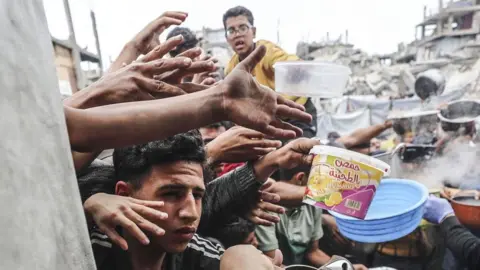 Getty Images
Getty ImagesThe UN World Food Programme says it has depleted all its food stocks in Gaza, where Israel has blocked deliveries of humanitarian aid for seven weeks.
“Today, WFP delivered its last remaining food stocks to hot meals kitchens,” it warned. “These kitchens are expected to fully run out of food in the coming days.”
Israel cut off aid on 2 March and resumed its offensive two weeks later after the collapse of a two-month ceasefire, saying it was putting pressure on Hamas to release its remaining hostages.
The UN says Israel is obliged under international law to ensure supplies for the 2.1 million Palestinians in Gaza. Israel says it is complying with international law and there is no aid shortage.
At the end of March, all 25 bakeries supported by the WFP in Gaza were forced to close after wheat flour and cooking fuel ran out. Food parcels distributed to families containing two weeks’ rations were also exhausted.
Malnutrition is also rapidly worsening, according to the UN. Last week, one of its humanitarian partners screened 1,300 children in northern Gaza and identified more than 80 cases of acute malnutrition – a two-fold increase from previous weeks.
The UN Office for the Co-ordination of Humanitarian Affairs (OCHA) says there are also severe shortages of medicine, medical supplies and equipment for hospitals overwhelmed by casualties from the Israeli bombardment, and that fuel shortages are hampering water production and distribution.
World Health Organization (WHO) director-general Dr Tedros Adhanom Ghebreyesus said “an awful and grim moment” had been reached in Gaza.
“This aid blockade must end. Lives depend on it.”
The WFP said the current Israeli blockade – the longest closure Gaza has ever faced – had exacerbated already fragile markets and food systems.
Food prices had skyrocketed by up to 1,400% compared to during the ceasefire, and the shortages of essential commodities raised serious nutrition concerns for vulnerable populations, including children under five, pregnant and breastfeeding women, and the elderly, it warned.
“The situation inside the Gaza Strip has once again reached a breaking point: people are running out of ways to cope, and the fragile gains made during the short ceasefire have unravelled. Without urgent action to open borders for aid and trade to enter, WFP’s critical assistance may be forced to end,” the agency said.
“WFP urges all parties to prioritize the needs of civilians and allow aid to enter Gaza immediately and uphold their obligations under international humanitarian law.”
More than 116,000 tonnes of food assistance – enough to feed one million people for up to four months – is positioned at aid corridors and is ready to be delivered as soon as Israel reopens Gaza’s border crossings, according to the agency.
In the meantime, WFP Country Director Antoine Renard told the BBC the agency was trying everything it could to keep the hot meals kitchens running.
“More than 80% of the population… have been displaced during the war. And just since 18 March [when the Israeli offensive restarted], you’ve got more than 400,000 people who have been displaced once again,” he said.
“Every time you move, every time you lose assets. So these kitchens are so essential for people to have a basic meal.”
However, even when fully supplied, the kitchens have been reaching just half the population with only 25% of daily food needs.
Gavin Kelleher, humanitarian access manager with the Norwegian Refugee Council, told the BBC from central Gaza that once the kitchens’ food stocks ran out they would no longer able to provide anything.
To survive, he said, people were eating less, bartering to “exchange a bag of diapers for lentils or cooking oil”, or selling what belongings they have left to try to get cash to access remaining food supplies.
He added that begging was also taking place on a scale not seen before in Gaza, but that people were not able to give to others anymore.
“The desperation is really, really severe.”

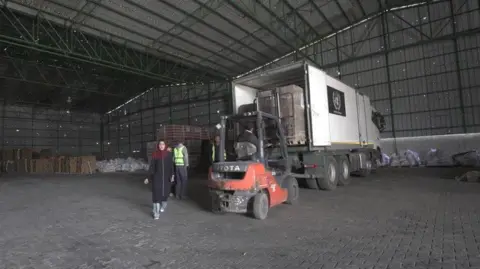 WFP
WFPEarlier this week, the Israeli foreign ministry rejected criticism of the blockade from the UK, France and Germany, which called it “intolerable” and demanded it end immediately in a joint statement.
The ministry said more than 25,000 lorries carrying almost 450,000 tonnes of aid had entered Gaza during the ceasefire, adding: “Israel is monitoring the situation on the ground, and there is no shortage of aid in Gaza.”
It also said Israel was not obliged to allow in aid because Hamas had “hijacked” supplies “to rebuild its terror machine”.
Hamas has previously denied stealing aid and the UN has said it has kept “a very good chain of custody on all the aid it’s delivered”.
Last week, Hamas rejected an Israeli proposal for a new ceasefire, which included a demand to disarm in return for a six-week pause in hostilities and the release of 10 of the 59 hostages still in captivity. The group reiterated it would hand over all of the hostages in exchange for an end to the war and a full Israeli withdrawal.
The Israeli military launched a campaign to destroy Hamas in response to an unprecedented cross-border attack on 7 October 2023, in which about 1,200 people were killed and 251 others were taken hostage.
At least 51,439 people have been killed in Gaza since then, according to the territory’s Hamas-run health ministry.
The HumAngle Foundation’s workshop on Advancing Peace and Security Through Journalism has reached its third and final day, marking the culmination of an impactful three-day training programme. The Foundation, a sister-organisation of HumAngle Media, is working to address issues around conflict and peacebuilding through advocacy.
Throughout the workshop, participants engaged in various sessions designed to enhance their skills and broaden their perspectives. Among the highlights were trainings on technology and innovative approaches to not only promote peacebuilding, accountability, and risk mitigation, but also promote good governance.
Since the commencement of the workshop on Wednesday, 23 April, topics like conflict and trauma-sensitive reporting, ethical reporting on sensitive issues, accountability journalism for peacebuilding, and stress management were covered.
Other sessions included human-centred storytelling, investigative reporting, and newsroom sustainability techniques.
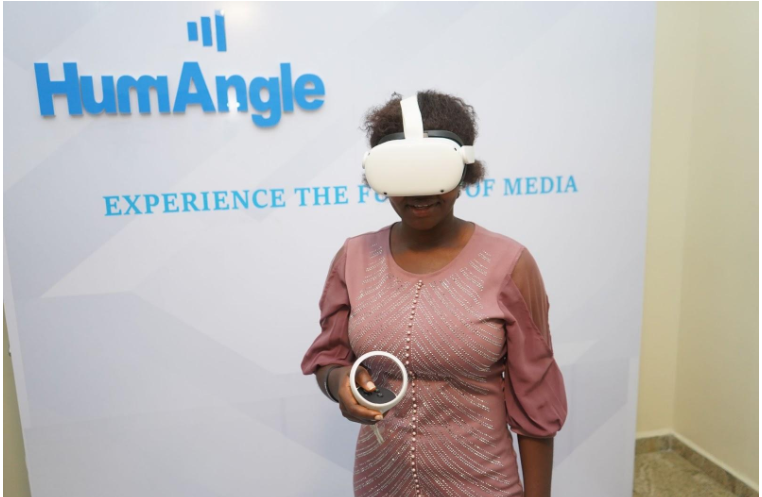
In the course of the final sessions, participants were taught how to utilise audience engagement strategies for impact, which emphasised the importance of connecting with diverse communities to foster understanding and drive meaningful change.
Shade Mary-Ann Olaoye, HumAngle’s Audience Engagement Editor, who facilitated one of the sessions, underscored the transformative power of audience engagement in driving social impact and fostering peacebuilding.
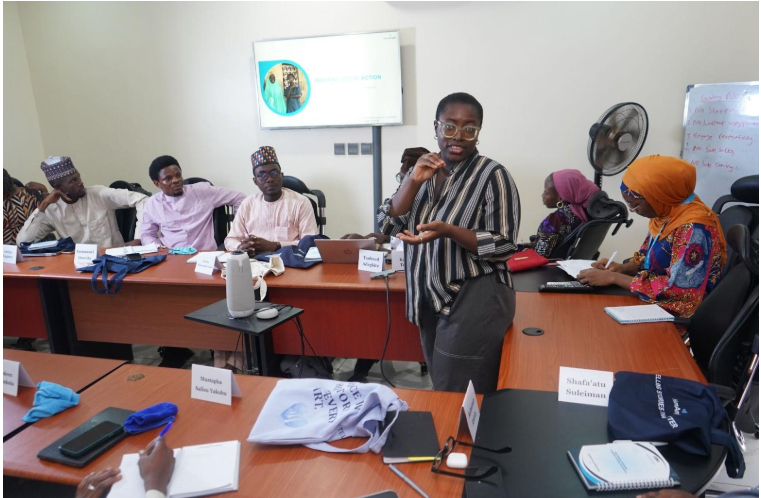
She emphasized that journalists must not only report stories but also actively engage with their audiences to inspire action and create a ripple effect of positive change. “When we connect with our audience on a deeper level, we can amplify voices that matter and catalyze solutions to pressing issues,” the editor remarked.
Adding to the depth of the workshop, Zainab Bala, the team lead for The Scoop Storytelling Initiative, shared insights on inclusive writing for peacebuilding. She highlighted the importance of amplifying diverse voices and ensuring that marginalised communities are represented in storytelling.
“Inclusive writing is not just about telling stories; it’s about creating narratives that bridge divides and foster understanding,” Bala stated.
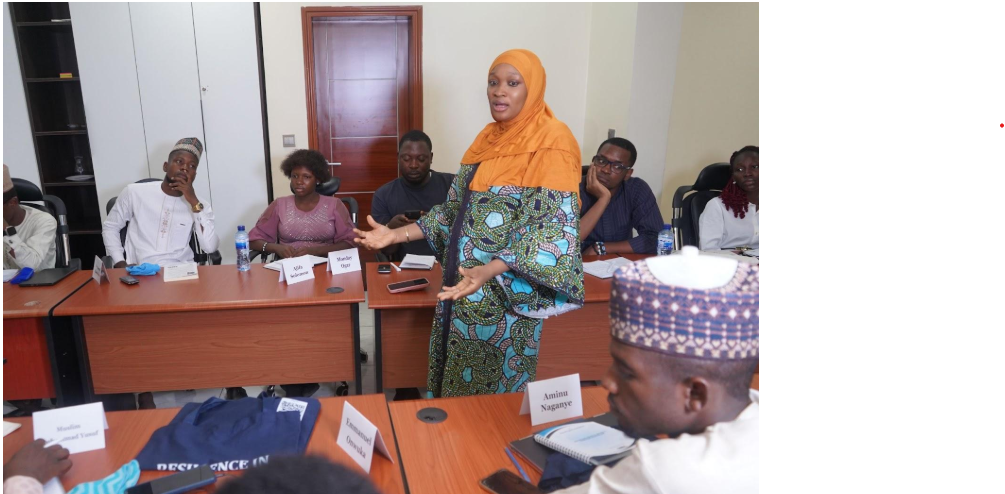
Her session inspired participants to adopt a more empathetic and inclusive approach in their reporting, emphasising that such practices are crucial for sustainable peacebuilding.
Experts at the workshop also highlighted the importance of interactive storytelling as a tool for fostering engagement and driving change. They emphasised that interactive storytelling allows audiences to actively participate in narratives, making them more invested in the outcomes.
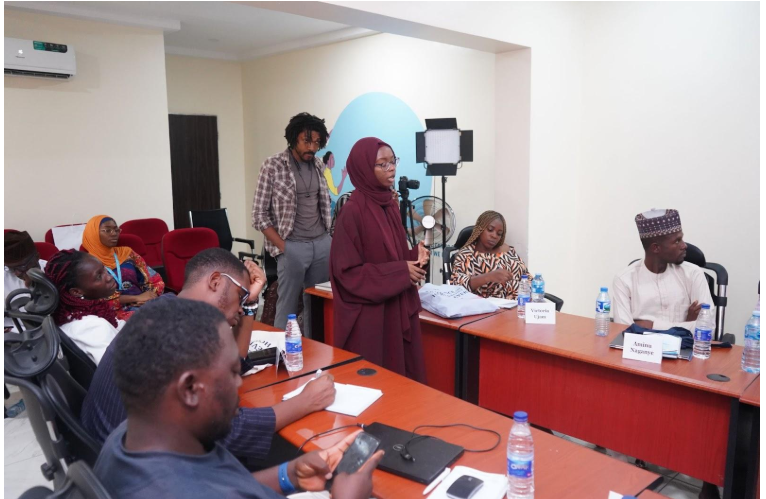
They revealed that interactive storytelling is not just about presenting facts but creating an experience that resonates with the audience and motivates them to take action.
Feedback from participants has been overwhelmingly positive as they expressed gratitude for the opportunity to not only learn from seasoned professionals but also network with peers from different regions for the purpose of peacebuilding.
Opeyemi Lawal, one participant from the Foundation of Investigative Journalism (FIJ), noted, “This workshop has equipped me with the tools I need. The sessions will increase my ability to report on sensitive issues and contribute to peacebuilding efforts.”
Also, Nurudeen Akeshuola, another participant from the International Centre for Investigative Reporting (ICIR), noted that the workshop has not only exposed him to innovative ways to tell better peacebuilding stories but has also given him a better understanding of the safety to embrace when covering conflict-affected communities.
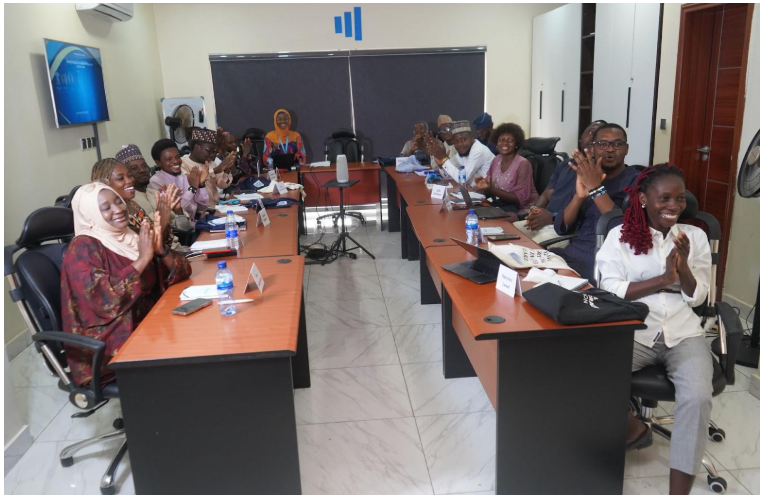
Regarding conducting a step-down training in their respective newsrooms, Rahman Abiola, the Editor-in-Chief of Legit, said he will not only ensure the efficient transfer of the knowledge gathered to his team but also see to its proper implementation in their newsroom. “Doing so will help us increase and refine our reporting on human-interest issues while advancing peace and security.”
The HumAngle Foundation’s Director, Angela Umoru-David, emphasised the importance of empowering journalists to advance peace and security through their work by ensuring increased coverage in these areas leads to stability and resilience in affected communities.
As the workshop concludes, participants are expected to apply the techniques learnt in their reporting and share their insights within their respective newsrooms through step-down sessions, with hopes that this initiative will inspire a new wave of journalism dedicated to promoting peace and security in Nigeria.
The workshop, supported by the National Endowment for Democracy (NED), brought together 15 journalists from across Nigeria to explore innovative approaches to conflict-sensitive reporting and peacebuilding.
The HumAngle Foundation recently concluded a three-day workshop aimed at advancing peace and security through journalism, with sessions focusing on technology, innovative approaches to peacebuilding, and ethical reporting.
The event covered essential topics like conflict-sensitive reporting, stress management, and human-centered storytelling, engaging 15 journalists from across Nigeria.
Shade Mary-Ann Olaoye stressed the impact of audience engagement, while Zainab Bala highlighted inclusive writing to represent marginalized voices.
The workshop, supported by the National Endowment for Democracy, emphasized the importance of interactive storytelling, and participants expressed gratitude for the skills acquired to contribute effectively to peacebuilding efforts.
US President Donald Trump says he expects to meet with foreign leaders while he’s in Rome for Pope Francis’s funeral. As he left the White House, he told reporters progress is being made on Russia-Ukraine talks and on Iran and emphasized his goal of cutting trade deals.
Published On 25 Apr 202525 Apr 2025
Russia and Ukraine have not held direct talks since the early weeks of the war, which started in February 2022.
US President Donald Trump’s envoy Steve Witkoff met Russian President Vladimir Putin for three hours in Moscow to discuss US efforts to end the Ukraine war, and the Kremlin said the two sides’ positions had moved closer.
Witkoff has emerged as Washington’s key interlocutor with Putin as Trump pushes for a deal to end the war, now well into its fourth year, and has already had three lengthy meetings with the Kremlin leader.
On Thursday, video published by Russian state media showed Witkoff meeting Putin at the Kremlin, with the two smiling, shaking hands and exchanging a few words in English before beginning talks.
Kremlin foreign policy aide Yuri Ushakov, who took part in the meeting with Witkoff on Friday, described the three-hour meeting as constructive and very useful.
“This conversation allowed Russia and the United States to further bring their positions closer together, not only on Ukraine but also on a number of other international issues,” he told reporters.
“As for the Ukrainian crisis itself, the discussion focused in particular on the possibility of resuming direct negotiations between representatives of the Russian Federation and Ukraine.”
Russia and Ukraine have not held direct talks since the early weeks of the war, which started when Putin ordered a full-scale invasion in February 2022.
Witkoff and the White House have not yet commented on the outcome of the meeting.
His latest trip follows talks this week at which Ukrainian and European officials pushed back against some of the US proposals for how to settle Russia’s war in Ukraine, the deadliest in Europe since World War II.
Trump has threatened to walk away from talks if he does not see progress towards a ceasefire.
On Thursday, after Russian attacks on Kyiv killed 12 people, Trump wrote on social media: “Vladimir, STOP!”, adding “Lets get the Peace Deal DONE!”
When asked how he would respond if Russia did not accept a deal, Trump said Thursday, “I won’t be happy, let me put it that way. Things will happen.”
Russia, which has warned against rushing into a peace settlement, said Thursday it was “ready to reach a deal” but needed certain issues addressed first.
“There are still some specific points … which need to be fine-tuned, and we are busy with this,” its foreign minister, Sergei Lavrov, told CBS News.
The United States has suggested freezing the front line and accepting Russian control of Crimea, a peninsula annexed by the Kremlin in 2014, in exchange for peace.
Trump was quoted in a TIME magazine interview published on Friday as saying, “Crimea will stay with Russia. And Zelenskyy understands that.”
Ukraine has rejected ceding ground to Moscow, and says it will not accept Russian control of Crimea, which has been occupied by Russia since 2014.
But Ukrainian President Volodymyr Zelenskyy has in recent months accepted that he might have to try to secure the return of some land captured by Russia through diplomacy once a ceasefire is in place.
Through the weekend, a gradual rise in temperature will be noticeable. By Sunday, England and Wales will see highs of 16 to 21C – just in time for the London and Manchester marathons – whilst Scotland and Northern Ireland will stay cooler and more unsettled.
It’s into Monday that the heat starts to build more widely, and then temperatures will increase day on day. The peak of the warm spell will be on Wednesday and Thursday.
Areas most likely to experience the warmest weather include central southern England to the west of London, such as Oxfordshire and Hampshire, and into the Midlands.
Collor, 75, held by federal police in the northeastern city of Maceio, capital of Alagoas state, lawyer says.
Brazil’s former President Fernando Collor de Mello has been arrested after a Supreme Court justice rejected his challenges against a previous conviction and ordered him to start serving jail time.
Collor’s lawyer, Marcelo Bessa, said the former leader was arrested at 4am (07:00 GMT) on Friday while travelling to Brazil’s capital Brasilia, where he planned to turn himself in after Supreme Court Justice Alexandre de Moraes’ arrest order.
The 75-year-old politician was being held by federal police in the northeastern city of Maceio, the capital of Alagoas state, Bessa said in a statement.
Moraes’ order on Thursday came after the top court sentenced Collor, the first president to win the popular vote after the end of Brazil’s last military dictatorship in 1985, to eight years and 10 months in prison in 2023 on corruption and money-laundering charges.
Collor’s lawyer had already voiced “surprise and concern” at Moraes’ decision in an initial statement released late on Thursday, but added that the former president would comply with the order.
The 2023 conviction came after Brazilian prosecutors accused Collor of receiving about 30 million reais ($5.28m) in bribes from a then subsidiary of state-run oil company Petrobras.
Collor took office as president in 1990, but did not finish his term as Congress decided to impeach him two years later amid a separate corruption scandal for which the Supreme Court acquitted him in 1994.
He was later elected as a senator representing the state of Alagoas.
He left Congress in early 2023 following an unsuccessful bid for governor of Alagoas.
Collor de Mello is not Brazil’s first president to run afoul of the law.
Four of the seven presidents who have led the country since the 1964-1985 military dictatorship have either been convicted, jailed or impeached.
In the latest case, far-right former President Jair Bolsonaro has been ordered to stand trial over an alleged coup plot after losing the 2022 election.
Surveillance cameras captured the moment a blast outside Moscow killed Russian Lieutenant General Yaroslav Moskalik.
Source link
Chris Eubank Jr will be fined £375,000 after missing the weight by just 0.05lb for Saturday’s grudge match with Conor Benn.
The 35-year-old weighed 0.2lb over the 11st 6lb limit on the first attempt and was still too heavy the second time.
A trimmed and toned Benn – who has operated at welterweight for most of his career – came in lighter than expected at 11st 2lb.
Eubank and Benn are both bound by a rehydration clause that prohibits them from weighing more than 12st 1lb on Saturday morning.
“Show me the money”, Benn posted in a video on social media.
The weigh-in took place behind closed doors at a London hotel on Friday.
There will be a ceremonial weigh-in, which will be open to the public, in Islington on Friday evening.
The fight is due to take place at Tottenham Hotspur Stadium.
Shai Gilgeous-Alexander scored 31 points and Jalen Williams had 26 to lead the Oklahoma City Thunder to an improbable and record-breaking 114-108 win over the Memphis Grizzlies to take a 3-0 lead in their Western Conference first-round series.
Chet Holmgren scored 23 of his 24 points in the second half on Thursday evening as the Thunder overcame a 29-point first-half deficit. Oklahoma City didn’t lead in the game until Williams dropped in a free throw with 1:20 remaining to go ahead 109-108.
Holmgren added two free throws with 57.4 seconds left and Alex Caruso scored on a breakaway layup with 19.4 seconds to go. The Grizzlies did not score in the final 4:51.
“We kind of reconnected to who we are (in the second half),” Oklahoma City coach Mark Daigneault said.
“We were very out of character in the first half, and some of that had to do with how well Memphis played and the way they landed the first punch and multiple punches after that. So credit to them. But I thought our response in a game that doesn’t feel attainable, our response was great.”
Memphis played without Ja Morant in the second half after he sustained a hip injury late in the first half. Scotty Pippen Jr scored 28 points to lead the Grizzlies. Jaren Jackson Jr added 22.

Morant had 15 points and five assists in 15 minutes before the injury. He was diagnosed with a left hip contusion. Without Morant, the Grizzlies were outscored 63-31 in the second half.
Morant left the game with 3:14 to go in the second quarter after falling hard on his left side while soaring in for a layup on a fastbreak. Morant was undercut by Luguentz Dort on the play. He hobbled slowly to the sideline after spending several minutes on the floor being attended by the Grizzlies’ training staff.
Morant returned to the court to take two free throws, which he missed, before being helped to the locker room.
Memphis interim coach Tuomas Iisalo said after the game that Morant would be evaluated on Friday, “and then we’ll know more”.
Memphis was coming off lopsided losses in the opening two games of the series in Oklahoma City – by 51 points in Game 1 and 19 in Game 2 – but played with renewed vigour in their home playoff opener.
Down 26 at the half, the Thunder doubled up the Grizzlies 36-18 in the third quarter. Midway through the period, Oklahoma City trimmed the lead to 10 points, mostly behind Holmgren. The 7-foot-1 forward had 16 points during a 25-9 run to open the quarter. A 3-pointer by Williams as the quarter ended cut the Thunder deficit to 95-87.
“I give a lot of credit to Chet because he had one point at halftime,” Daigneault said. “He had a very, very quiet, subdued first half. And then the mental toughness to stay in it … was really impressive. And he did a good job defensively as well.”
The Grizzlies built a double-digit lead in the first quarter. The catalyst was Pippen, who had four of the team’s eight 3-pointers in the quarter. The Grizzlies led by 12 points on three occasions late in the period.
The Grizzlies extended their advantage to 28 points (65-37) midway through the second quarter following a 25-5 run that included 16 consecutive points. Morant scored nine points during the run, and Pippen had seven. The lead stretched to 29 points at 69-40 with 3:07 to go on a layup by Desmond Bane.
“We did a great job fighting for 48 minutes, but against this team it’s not enough to fight, you also have to be able to execute,” Iisalo said.
Memphis led 77-51 at halftime by shooting 57.4 percent and committing only three turnovers. The Grizzlies scored only 80 points in Game 1.
Kawhi Leonard recorded 21 points, 11 rebounds and six assists and Los Angeles took a 2-1 series lead with a convincing victory over Denver at Inglewood, California.
James Harden had 20 points – all in the first half – to go with nine assists and six rebounds, while Norman Powell also scored 20 for the fifth-seeded Clippers. Ivica Zubac registered 19 points and nine rebounds as Los Angeles won its second straight in the best-of-seven, first-round series.
Denver star Nikola Jokic recorded 23 points, 13 rebounds and 13 assists for his 20th career postseason triple-double. Jamal Murray also scored 23 points and Aaron Gordon added 15 points and seven rebounds for the fourth-seeded Nuggets.
Karl-Anthony Towns scored 31 points and Jalen Brunson added 30, including 12 in the fourth quarter, to give visiting New York a victory over Detroit in Game 3 of their Eastern Conference first-round playoff series.
OG Anunoby put up 22 points for the Knicks, who hold a 2-1 lead in the best-of-seven series on Sunday in Detroit. Brunson, who averaged 35.5 points in the first two games, also had nine assists and seven rebounds in Game 3.
Cade Cunningham and Tim Hardaway Jr led Detroit with 24 points apiece, and Cunningham dished out a game-high 11 assists. Dennis Schroder scored 18 points for the Pistons, who have not won a home playoff game since May 2008.
Independent UK MP Shockat Adam describes how conditions in the occupied West Bank are dehumanising Palestinians.
Source link
At least 59 people, including children, have been killed in a barrage of Israeli attacks across the besieged Gaza Strip, medical sources told Al Jazeera.
Rescue teams and medics in the enclave said at least 12 people belonging to the same family were among those killed on Thursday when their home in northern Gaza’s Jabalia was targeted.
Six members of another family – a couple and their four children – were killed when an air strike levelled their home in Gaza City, the civil defence said in a statement.
Ahmed Arar, a first responder in Gaza City, said there were “large quantities of body parts and remains”, including those of many children, after the attack.
“There are only hands, legs, and heads. They are all severed and torn,” Arar told Al Jazeera.
Another 10 people were killed and several others wounded in a strike on a former police station in the Jabalia area of northern Gaza, according to a statement from the Indonesian Hospital, where the casualties were taken.
“Everyone started running and screaming, not knowing what to do from the horror and severity of the bombing,” 23-year-old Abdel Qader Sabah, from Jabalia, said of the attack that hit the station that is located near a market.

Israel’s military said it struck what it described as a Hamas “command and control centre” in the Jabalia area, without clarifying if it was targeting the police station. The army has previously used similar justifications in attacks that hit hospitals and numerous shelters housing displaced Palestinian families.
At least 26 people were killed in other Israeli attacks across the territory, according to medics and the civil defence agency.
Al Jazeera’s Tareq Abu Azzoum, reporting from Deir el-Balah, said there is “an ongoing surge in the rate of Israeli attacks on the entire Gaza Strip”.
He said that civil defence crews are still working to dig through the rubble at the scene of the latest attack in Jabalia.
He cited one rescue worker as saying many of the victims have sustained burn wounds.
Israel resumed its military assault on the Gaza Strip on March 18, ending a two-month ceasefire that had brought a temporary halt to fighting in the blockaded territory.
The military is continuing to seal vital border crossings for the eighth week in a row, denying the entry of much-needed humanitarian aid, including medical supplies and fuel, worsening an already deep humanitarian crisis amid relentless bombardment.
Israel’s army chief, visiting troops in Gaza on Thursday, threatened a “larger” offensive if captives seized in the Hamas-led attack on Israel on October 7, 2023, are not freed.
“If we do not see progress in the return of the hostages in the near future, we will expand our activities to a larger and more significant operation,” Eyal Zamir said.
The Israeli military, meanwhile, ordered Palestinians living in the northern areas of Beit Hanoon and Sheikh Zeid to evacuate in advance of an attack.
The United Nations has warned that Israel’s expanding evacuation orders across Gaza are resulting in the “forcible transfer” of people into ever-shrinking areas.
Aid agencies estimate that the vast majority of Gaza’s 2.4 million residents have been displaced at least once since the war began.
Also on Thursday, the Gaza Health Ministry said the Durra Children’s Hospital in Gaza City had become nonoperational, a day after an Israeli strike hit the upper part of the building, damaging the intensive care unit and destroying the facility’s solar power panel system.
Gaza’s health system has been devastated by Israel’s 18-month-old military campaign, putting many of the territory’s hospitals out of action, killing medics, and reducing crucial supplies.
Efforts by key mediators Qatar and Egypt, backed by the United States, have so far failed to produce a lasting ceasefire.
Since Israel resumed its assault, at least 1,978 people have been killed in Gaza, raising the overall death toll to at least 51,355 since October 2023, according to the Gaza Health Ministry.
The military said Thursday that Israeli tank fire killed a UN worker in the central Gaza city of Deir el-Balah last month, according to an investigation’s initial findings.
It had initially denied operating in the area where a Bulgarian employee of the United Nations Office for Project Services (UNOPS) was killed on March 19.
The findings come after the military on Sunday reported on a separate probe into the killing of 15 Palestinian emergency workers in Gaza.
It finally admitted that operational failures led to their deaths, and said a field commander would be dismissed.
The jersey worn by Kobe Bryant on his Los Angeles Lakers debut in 1996 has sold for $7m (£5.26m) at auction.
The jersey, worn by Bryant during his 1996-1997 rookie season, becomes the fourth-most expensive game-worn sports jersey of all time.
The American spent his entire career with the Lakers, winning the NBA Championship five times and being crowned the Most Valuable Player once in 2008.
The jersey was first sold for $115,242 in 2013, seven years before Bryant and his daughter Gianna died in a helicopter crash.
“Debut games are truly one-of-a-kind moments in an athlete’s career,” said Brahm Wachter, head of modern collectibles at auctioneers Sotheby’s.
US loses drones in Yemen as rising civilian toll fuels backlash over Trump’s air campaign.
Yemen’s Houthi armed group has shot down seven US Reaper drones worth more than $200m in recent weeks, marking the most significant material loss yet in Washington’s campaign against the fighters.
The drones were destroyed between March 31 and April 22, according to defence officials, as the Houthis step up efforts to target United States aircraft operating over Yemen.
Three of the drones were lost in the past week alone, suggesting an improvement in the Houthis’ ability to strike high-altitude US aircraft.
The drones – each costing about $30m – were conducting surveillance or attack missions when they crashed into water or land. A defence official said the strikes occurred on March 31 and on April 3, 9, 13, 18, 19 and 22, according to The Associated Press news agency.
Dozens of civilians have been reported killed in Houthi-controlled parts of Yemen since March 15 after US President Donald Trump ordered daily strikes against the group.
Central Command spokesperson Dave Eastburn said on Thursday that US forces have struck more than 800 targets, destroying command centres, weapons depots and air defences, and killing hundreds of Houthi fighters and leaders. This claim could not be independently verified.
Another US official, speaking on condition of anonymity, said the drone losses are under investigation but are likely the result of hostile fire, the AP reported.
The Houthis have targeted mainly Israeli, US and British ships passing through the Bab al-Mandeb Strait in protest against Israel’s war on Gaza. The group has said the attacks would stop if Israel agreed to a permanent ceasefire.
The Trump administration appears to have shifted from targeting only infrastructure to deliberately striking figures within the Houthi movement.
The strategic change comes amid rising civilian casualties from the US-led campaign, according to Airwars, a UK-based monitoring group.
Airwars estimates that between 27 and 55 civilians were killed in US strikes during March. The group believes the toll in April is already considerably higher, though full figures remain unconfirmed.
Earlier this month, a US air strike targeted the Ras Isa port, also in Hodeidah, killing at least 80 people and wounding more than 150.
This was followed by another attack on Monday, which killed 12 people and wounded more than 30 others in Yemen’s capital Sanaa.
Concerns are growing in Washington over the human cost of the campaign.
Senators Chris Van Hollen, Elizabeth Warren and Tim Kaine have written to Defence Secretary Pete Hegseth, questioning whether the administration is abandoning its responsibility to reduce civilian harm, particularly after reports emerged about the high civilian death toll on the Ras Isa fuel terminal.
Langtang, Nepal – On the morning of April 25, 2015, Nima Chhiring Tamang, 30, left his home in northern Nepal’s Langtang village to spend time with friends in the neighbouring village of Kyanjin Gompa – about a three hour walk through the Himalayas, in the shadow of the towering 7,234-metre (13,733-foot) Langtang Lirung peak.
Chhiring had recently completed his university education in the capital, Kathmandu, a three-day walk combined with an eight-hour drive away, and returned to his home in the mountains.
Chhiring was playing cards with his friends when a magnitude 7.8 earthquake struck the region, triggering a glacial avalanche that engulfed his village below. His mother, Karmu Tamang, was killed, along with nearly 300 others in Langtang, and 9,000 throughout the country. The avalanche brought an estimated 40 million tons of rock and ice bearing down on the village, carrying half the force of an atomic bomb and reducing the village to rubble.
Only one building was left standing, a single house sheltered under a rock face.
Ten years later, Langtang is bustling with life again, serving as a popular trekking destination for tourists from all over the world. Grazing yaks greet hikers as they walk beneath strings of prayer flags, pausing to examine the earthquake memorial – stacks of stones etched with Buddhist mantras, honouring the lives lost in the tragedy.

The village falls within the Langtang National Park, which was established in 1976 to protect the region’s rare and endemic flora and fauna. That led to a spike in tourism to the region in the 1980s, forever altering the lives of Indigenous inhabitants within the park’s boundaries.
But the village lacked significant facilities to host the steady stream of tourists.
Following the earthquake, Langtang embraced tourism-driven development, with nearly every house in the village turning into a guesthouse with modern amenities, including WiFi for those tourists who want to embrace the wild while retaining the comforts of home.
Yet some residents now express dismay that the village is unrecognisable, both aesthetically and culturally. Anxious locals worry that the rebuilding came at the expense of social cohesion in the village and led to communities abandoning traditional activities, like yak herding and foraging for medicinal plants.
“Everyone here only cares about money and hotels now. There’s lots of competition for tourists. Before life was simple, and there was peace,” said Chhiring. While Langtang had been welcoming tourists before the earthquake, the atmosphere was more communal and supportive, and families didn’t push to get tourists into their guesthouses, he explained.
In the aftermath of the quake, international aid poured into Nepal, with a host of development organisations implementing a top-down approach and dictating the rebuilding process – how, when, where, and what to rebuild. The Asian Development Bank committed more than $600m to “build back better.”
But aid was often delivered in the form of loans with interest and other strings, leaving Nepal increasingly indebted.

Yet in Langtang, due to both its isolation and the determination of residents, the rebuilding efforts were largely organised by grassroots efforts, chiefly the Langtang Management and Reconstruction Committee – a community-led effort formed three months after the quake to facilitate rebuilding and raise funds. The committee was formed among the Langtangpa, the people of Langtangpa Valley – which contains around twenty-five villages, but with Langtang Village bearing the brunt of the disaster – who were living as refugees in Kathmandu and wished to facilitate a quick return to their land.
“In the weeks that followed the earthquake, government authorities said maybe the Langtangpa wouldn’t be able to return,” explained Austin Lord, an anthropologist who was hiking in Langtang at the time of the earthquake and later published a dissertation at Cornell University on the disaster and its aftermath. “This sparked a strong desire to self-organise, which ultimately proved quite successful.”
But locals didn’t have enough funding to build separate homes and businesses, so they combined the two projects, explained Lhakpa Tamang, secretary of the reconstruction committee.
That’s when problems began to arise, he suggested.
“With business, jealousy comes. Who’s gonna do better? Who is gonna earn more?” quipped Lhakpa. Quarrels happened over the size of prospective guesthouses, and community ties faltered. “There are always two sides of tourism: good and bad. Development sacrifices culture, but at the end of the day, people need money.”

Today, with nearly every building in Langtang Village is a guesthouse, families often sleep in the common room around a wood-burning stove during the peak seasons: March to May and September to November. Before the quake, the village mostly consisted of scattered tea houses, built with organic materials, primarily stone and timber. The landscape of Langtang is now dominated by concrete buildings with modern amenities, some rising three storeys tall from the ashes.
Still, the guesthouses brought badly needed income to families like that of Nurchung Tamang.
After losing everything, Nurchung, who now operates the Chhomo Valais Guest House in Langtang, told the story of how his family was evacuated to Kathmandu after the earthquake, but eventually decided to return to the rubble. The capital city was inundated with a wave of refugees fleeing the devastation across the countryside.
“We had no money in Kathmandu, so we stayed at the monastery with the monks,” said Nurchung. The people of Langtang Valley migrated from Tibet about a thousand years ago, and they are devout Buddhists in a Hindu-majority country, roughly 9 percent of the population.
After years of living in poverty in Kathmandu, families began trickling back into the devastated Langtang Valley. “There was nothing left at first, so we planted barley and potatoes and stayed in tents and did what we could to earn income,” explained Nurchung.
Nurching’s family started their rebuilding efforts with the help of foreign volunteers who had previously visited Langtang – that families with fewer international friends and connections received less external help was another source of contention – but obtaining materials was not straightforward. Langtang Village is a three-day hike from the closest road and sits at an elevation of 3,430 meters (11,253 feet), high enough to induce altitude sickness, especially during strenuous physical activity. Construction materials had to be carried on the backs of porters, strapped to mules, or flown in with helicopters at huge expense.

Large machinery cannot be carried in at all, leaving the old Langtang Village still largely buried beneath the rubble. Instead of attempting to excavate the debris, a new village was constructed nearby. Because the village sits within Langtang National Park, the Langtangpa had limited space to expand. Residents were forced to rebuild in a cramped area free of avalanche debris and compete for space for their guesthouses.
Before the disaster, there were approximately 50 families in Langtang Village. Today, fewer than half remain. Some were killed, others moved away. Money was scarce and people were desperate, leaving much of the rebuilding process to be dictated by efforts to rapidly develop income-generating tourism infrastructure, as opposed to daily necessities like healthcare facilities, which have not been built in the village 10 years later. Today, there is a small clinic in neighbouring Mundu, but facilities are basic, and it is staffed by only a paramedic.
“There is an unfortunate trickle-down effect with aid, with it often not reaching where it’s needed,” explained Cherie Rezen, a US nurse who is leading a two-day healthcare mission to the village for the anniversary of the disaster. Rezen and Dr Amar Raut, co-founders of the NGO Embrace Nepal, are planning on doing health screenings for residents and carrying in a variety of heavy medical equipment with them, including an ECG machine. The elderly, in particular, rely on these health camps for medical care, as it is challenging for them to leave Langtang Valley.
Today, foreign tourists embarking on the roughly six-day Langtang Trek are beckoned into one newly built guesthouse after the next. Tenacious women with long black braids in traditional Tamang dress – the Tamang are one of Nepal’s 142 recognised ethnic groups and the majority of the population of the valley – hand out printed business cards for their guesthouses. With snow-capped peaks in the backdrop, signs across the valley read: “We have hot showers and Western food at no extra cost!”
“The disaster definitely accelerated the transition away from agro-pastoral livelihoods to a heavy dependence on the tourist economy,” said Lord.

The yak herders are dying out, and the next generation is more focused on gaining education that was inaccessible to their parents and grandparents, with many young Langtangpa opting to move to Kathmandu or go abroad to study. About 8 percent of Nepal’s population lives outside the country, driven away by a poor economy and a lack of job prospects. Many are enticed to stay only by carving out a role in the country’s tourism industry.
“Langtang had almost no tourism 50 years ago. Our grandmothers made us clothes with yak wool. Life was happier before, but this is the way of life now. When you need to go forward and develop, going back is not possible,” explained Lkhapa, the rebuilding secretary, who is a resident of the neighbouring Kyanjin Gompa.
Today, he hands out fresh cinnamon rolls to tourists in luxury alpine gear while recounting his role in recovery efforts, retrieving bodies when the snow finally melted.
“Langtangpas did the best they could to build back, and, after all their suffering, they built a new version of Langtang based on what they thought would bring them material security. They also built a version of Langtang for the future generation to come back and take over – most think a vibrant tourism economy is the best way to ensure their children come home.”
Climate change continues to threaten the survival of the village. A 2024 study found that it exacerbated the impacts of the avalanche, and the village faces increasingly warming temperatures and erratic snowfall. When asked why return at all, Chhiring thought for a moment and responded: “It’s our motherland, we have to respect that.”